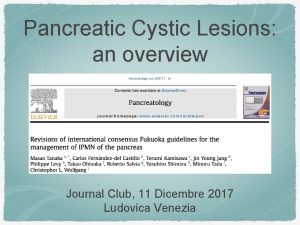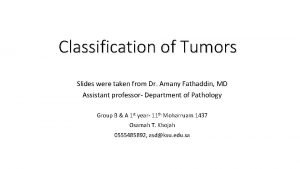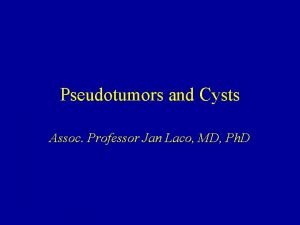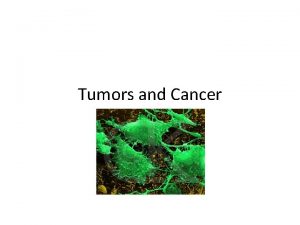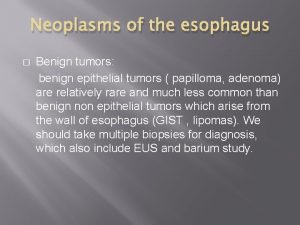Chapter 8 Neoplasms Terminology of Neoplasms and Tumors






















- Slides: 22

Chapter 8 Neoplasms

Terminology of Neoplasms and Tumors • Neoplasm • Tumor • These 2 terms can be used interchangeably – Exceptions: hematoma & leukemia

Classes of Neoplasms • 2 large classes – Benign tumors – Malignant tumors

Classes of Neoplasms • Benign tumors – Treatment:

Classes of Neoplasms • Malignant tumors – Metastasis may occur:

Naming Neoplasms • Benign tumors – Polyp/papilloma – Others named by adding suffix –oma to a prefix of cells origin

Naming Neoplasms • Malignant tumors – Classified into 3 groups • Carcinoma • Sarcoma • Leukemias

Naming Neoplasms • Naming exceptions – Lymphoid tumors – Skin tumors of pigment-producing cells – Tumors of mixed cellular components

Naming Neoplasms: Exceptions • Lymphoid tumors – Lymphoma

Naming Neoplasms: Exceptions • Skin tumors of pigment-producing cells – Epidermis contains melanocytes • Produce: – Benign skin lesion – Malignant skin lesion

Naming Neoplasms: Exceptions • Nevus vs. melanoma – ABCD’s

Naming Neoplasms: Exceptions • Tumors of mixed cellular components – Teratoma

Development of Malignant Neoplasm • Multiple genetic mutations/alterations of DNA must occur • Causes of genetic mutations – Exposure to carcinogens such as:

Development of Malignant Neoplasm • Continued exposure promotes abnormality of the cells – Abnormal cells attempt to become established & thrive • If not firmly established they are considered preneoplastic or precancerous • If precancerous cells invade surrounding tissue it becomes a malignant neoplasm • With continued exposure: normal hyperplasia dysplasia metaplasia neoplasia

Grading and Staging of Neoplasms • Used to determine prognosis & plan of treatment – Usually requires a biopsy • Removing a small piece of tissue • Grading (I-IV) – Microscopic examination to determine how abnormal cells are • Grade I tumors: resemble normal cells • Grade IV tumors: undifferentiated & grow rapidly • Staging (I-IV) – Determines extent of spread of a neoplasm • Stage I tumors: localized & small • Stage IV tumors: metastasized • The higher the number the more widespread (poor prognosis)

Cancer Prevention • American Cancer Society Recommended preventative measures: – Do not smoke – Limit alcohol intake – Protect skin from excessive sun exposure – Use hormone therapy only as long as necessary – Avoid heavily polluted air, household solvents, and paint thinners – Monitor calorie intake and exercise

Cancer Prevention • Monthly examinations – Breast • Regular checkups – Mammogram – Papanicolaou (pap) smears for females – Prostate examinations for males – Rectal examinations for males and females

Frequency of Cancer • Second leading cause of death in United States • Affects one in two males and one in three females • Affects people of all ages – Both male and female • Most common: – Basal and squamous cell skin cancer

Frequency of Cancer • Most common (excluding skin cancer): – Lung – Colon – Breast – Uterus – Prostate

Diagnosis of Cancer • Prognosis best if found treated early – Routine screening helpful – May be found accidentally • Once discovered, biopsy recommended

Cancer Treatment • Treatment can be – Curative: – Palliative: – Preventative: • Treatment may include: – Surgery – Chemotherapy: – Radiation:

? ? QUESTIONS ? ?
 Neoplasms
Neoplasms Malignant and benign tumors
Malignant and benign tumors Benign and malignant tumors
Benign and malignant tumors Teratoma
Teratoma Ectocervix
Ectocervix Response evaluation criteria in solid tumors (recist)
Response evaluation criteria in solid tumors (recist) Codman üçgeni
Codman üçgeni Exostosis
Exostosis Anterior ramus of spinal cord
Anterior ramus of spinal cord Brain tumors
Brain tumors Acromely
Acromely Paresthiasis
Paresthiasis Ipmn
Ipmn Classification of tumors
Classification of tumors Classification of tumors
Classification of tumors Odontogenic tumors classification
Odontogenic tumors classification Enneking classification of benign bone tumors
Enneking classification of benign bone tumors Odontogenic tumors
Odontogenic tumors Ameloblastoma rtg
Ameloblastoma rtg Ata thyroid
Ata thyroid Chapter 1 veterinary medical terminology and abbreviations
Chapter 1 veterinary medical terminology and abbreviations Chapter 11 medical terminology
Chapter 11 medical terminology Pyelo medical terminology
Pyelo medical terminology












